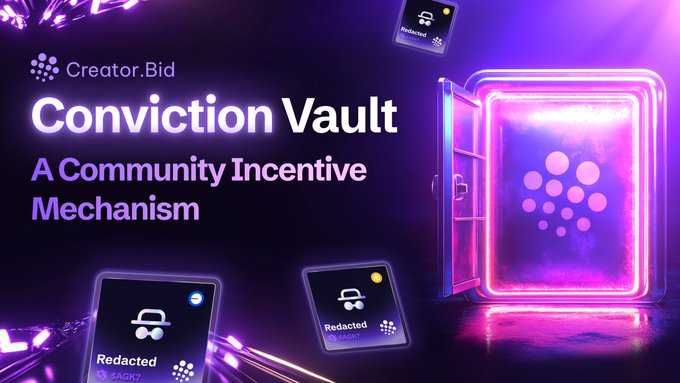Background and Multi-Chain Expansion Progress
On February 25, 2025, AI agent platform CreatorBid announced its integration with BNB Chain, expanding its ecosystem originally built on the Base network into a multi-chain architecture. This upgrade aims to leverage BNB Chain’s high throughput (over 2,000 TPS) and low transaction costs (approximately USD 0.05 per transaction) to attract more developers and AI projects. Previously, CreatorBid had established three pillars on the Base network—Launchpad, token economic model, and Creator Hub—to support fair launches for AI agents, tokenization, and on-chain service integration.
The BID token has a circulating supply of approximately 268 million tokens. Holders on Base and BNB Chain currently number about 61,000 and 5,907, respectively, with token distribution being well diversified and the top 100 holders accounting for less than 35%.

Technical Architecture and Multi-Chain Advantages
CreatorBid’s core functionality revolves around the fair launch of AI agents and cross-chain collaboration. Its Launchpad employs an anti-sniping bond curve and an automatic liquidity guidance system to balance the interests of project teams and the community. For example, when the liquidity of Agent Keys reaches a preset threshold (e.g., 7.4 ETH), the system automatically deploys trading pairs on Uniswap (Base) or PancakeSwap (BNB Chain) to prevent early whale manipulation of prices. This mechanism successfully withstood a DDoS attack during the Aion5100 agent launch in January 2025, demonstrating its technical stability.
The key to multi-chain expansion lies in restructuring the token economic model. The BID token features a deflationary design where token burn generates BID points used to pay for AI agent services. Integration with BNB Chain enables developers to call cross-chain APIs (e.g., for member address retrieval and agent metadata) to build complex applications. This flexibility differentiates CreatorBid from competitors like Virtual Protocol, which only supports a single chain and relies on centralized data sources.
Market Impact and Ecosystem Potential
BNB Chain’s inclusion significantly expands CreatorBid’s coverage. Developers in Asian markets—especially in Southeast Asia—can quickly deploy AI agents on BNB Chain due to its low cost, bypassing the high Gas fees (around USD 0.8 per transaction) on the Base network. For instance, a Singaporean team used CreatorBid’s SDK to build an automated content generation tool on BNB Chain, reducing transaction costs by 80%.
The BID token economic model also boosts market confidence. The combination of the burn mechanism and the Dynamic Incentive Mechanism (DIM) allows token holders to earn rewards through staking. On-chain data shows that the current annual staking yield for BID is about 8%-15%, attracting institutional investors. In March 2025, the first AI agent Algo on BNB Chain generated USD 50,000 in fee revenue over 24 hours, with 30% permanently locked in the liquidity pool, validating the ecosystem’s revenue-generating potential.
Potential Risks and Challenges
Despite its promising outlook, CreatorBid faces several challenges:
- Regulatory Risks: The “security attributes” of the BID token may trigger SEC scrutiny, especially if the public portion (10% of total supply) is deemed an unregistered security, potentially leading to delisting from exchanges.
- Node Centralization on BNB Chain: The top 21 validators control 80% of the network’s power on BNB Chain, which could undermine the platform’s claimed “decentralization” advantage.
- Technical Complexity: Multi-chain interactions may expose smart contract vulnerabilities. In December 2024, an AI agent on the Base network had USD 50,000 worth of assets locked due to a cross-chain communication error; although the team fixed the issue, it damaged user confidence.
- Rapid Rise of the Solana Ecosystem: Competitors such as SOLENG have achieved automated code auditing, potentially diverting developer resources. CreatorBid must build strong barriers in terms of tool usability.
Future Outlook and Ecosystem Expansion
CreatorBid plans to launch its Creator Hub in Q2 2025, offering two types of AI agent models: Agent-as-a-Service (AaaS) and Custom Agents. The former allows non-technical users to create social media AI characters through a managed solution, while the latter enables developers to build complex applications via cross-chain APIs. Additionally, the platform aims to expand to a third blockchain network (likely Polygon or Avalanche), further lowering regional entry barriers.
In the long term, CreatorBid’s goal is to become the foundational protocol layer for the AI agent economy. If its deflationary model and multi-chain service network are successfully implemented, the BID token could follow a path similar to Chainlink (LINK), transitioning from a utility token into an ecosystem value carrier. Investors are advised to track price volatility and use agent metadata APIs to evaluate ecosystem activity. In the wave of AI and blockchain convergence, multi-chain expansion gives CreatorBid a first-mover advantage, though its sustainability will depend on ongoing technological iterations and robust regulatory compliance.




